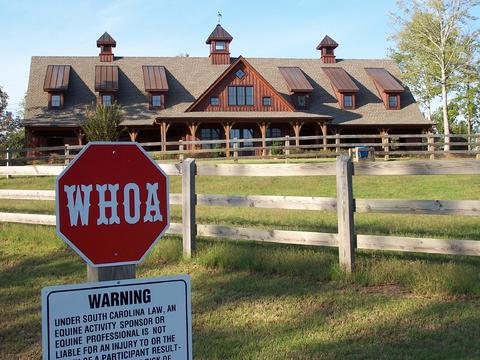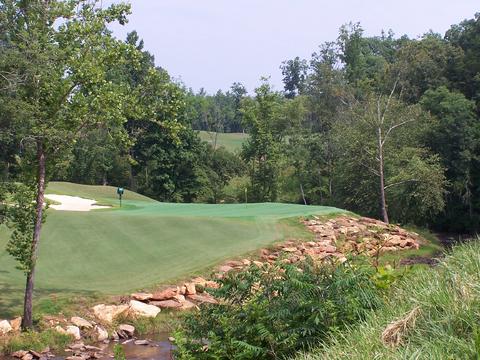
Non-equestrian golfers might want to stop and ask who will pay eventually for equestrian centers in communities like this one at The Cliffs at Keowee Vineyards.
I like horses, especially at Kentucky Derby time. I would not mind living in a community with horses. When I toured Mount Vintage Plantation in Aiken, SC, last year, the sight of the stallions behind the white fences in someone's front yard was picture postcard perfect.
I have nothing against physical fitness either, and admire those who jog, pump iron and work the treadmill on a regular basis. I am jealous of their discipline (and their lack of body fat).
In the push to be competitive, new golfing communities are loading up on the amenities, not just lavish equestrian and fitness centers, but also spas, swimming pools with waterfalls, full-time naturalists and marinas. This is great stuff, but raises some questions: How many amenities will you use on a regular basis? How much will they cost you (if not today then down the line)? And will the extras affect positively the value of your home when it comes time to sell?
If you are a fit-as-a-fiddle, three-day-week-golfer who rides horses another three days a week, works out four days as well and takes contemplative walks with the community's naturalist, then a place like The Cliffs Communities or one of the other amenities-loaded developments will have strong appeal. But, come on, how many of us have the time, dedication and discretionary assets to indulge in so many passions? If you are "just" a golfer, do you want to subsidize the activities of others in exchange for the prestige of living in a community with a wide range of activities?
Someone has to pay for the amenities. Initially it is the developer, who uses them as a lure to sell lots and homes. A wide range of amenities will appeal to the widest possible market of potential buyers. You can't blame them from a marketing standpoint and, certainly, no one minds sharing space at this point with those who have passions other than our own.
But someday the piper must be paid. Developers will turn over the community to the homeowners - it is required by state law in most places - and then comes the day of reckoning. In well-planned transitions, the owners know what to expect in terms of increased dues, and the process is relatively painless (but the dues always rise). But in other cases, sticker shock sets in, with some tough choices needing to be made about who pays for what and how much. Sometimes the alternatives are to turn the activity over to some outside manager who then charges an extra fee to use the facilities. Whatever the outcome, the discussion can pit golfers against horse lovers, boat owners and nature lovers. All those amenities that gave the community a certain cachet start to look like expensive luxuries.
The effect of the amenities on the value of your home is a tougher question. If you have faith in the wisdom and business acumen of developers, then you can count on the value of the amenities being built into the initial price of the home you buy in an amenities-loaded community. In that case you hope when it comes time to sell that some golf nut, horse nut or fitness nut interested in your house will be happy to pony up a price for the value of the amenities and won't be daunted by whatever the homeowner association dues are set at.
A few simple things to keep in mind when looking at property in one of these amenities-loaded communities:
Ask how the amenities are paid for. What is the history of dues increases for the homeowners? If the developer is subsidizing the amenities, what is the plan for turning them over to the homeowners or a management company? When will the turnover occur?
Golfers who don't want to subsidize the passions of others have a viable alternative that could shave a few hundred thousand dollars off their home price and a few hundred a month in dues. Consider purchasing a home that is not inside a gated or golfing community but is close to a good private or semi-private country club. Many of the nation's nicest country clubs are hungry for new members. I've visited and played some excellent private courses, including the Fazio-designed Thornblade Club in Greer, SC, a sleek layout set right in the middle of an unaffiliated community (pro golfer Jay Haas lives in a house overlooking the course). Homes run anywhere from about $400,000 for a condo overlooking the course to $1 million or more for a large single-family home.
Fox Den Country Club in Farragut, TN, near Knoxville, is set within a neighborhood of older homes that are quite reasonably priced. Fox Den is a classic that plays host to an annual Nationwide Tour event. So too does Rock Barn in Conover, NC, home of the Senior Tour's Greater Hickory Classic. Rock Barn offers two 18-hole courses, one by Robert Trent Jones, Jr, and the other by Tom Jackson, and membership confers use as well of the community's spa and health facilities.
One other option is to join a golf club that is inside a community without actually living in the community. Many in-community clubs offer non-resident golf memberships. Should you lose that $5 Nassau to a fellow member who happens to live inside the gates, you can hand over the money with a smile, content in the knowledge that you may have paid a lot less for your comparable home than he did.
Note: As a service to our readers, we would be happy to put you in touch with a real estate agent whom we have qualified as knowledgeable about golf course communtiies in these areas.

One of the two Rock Barn golf club courses sports plenty of rocks and typical Trent Jones, Jr. sand bunkers. The course plays host to a Senior PGA event.



